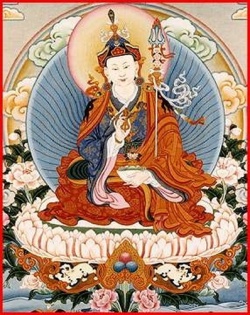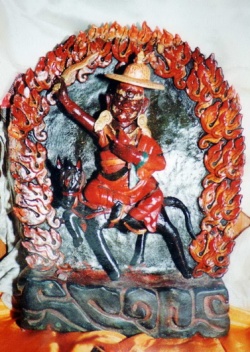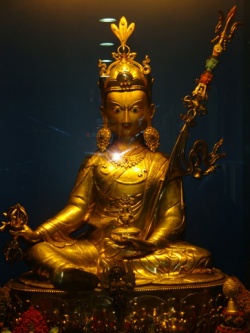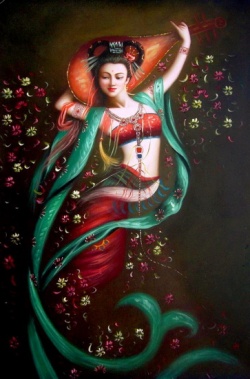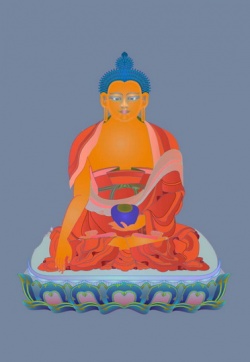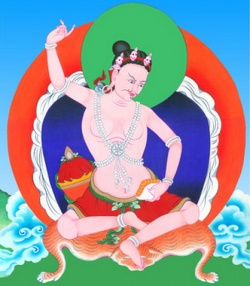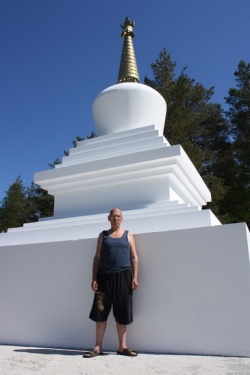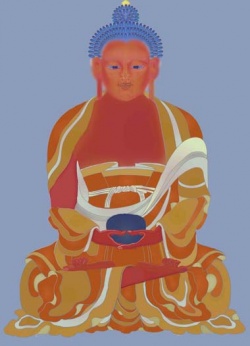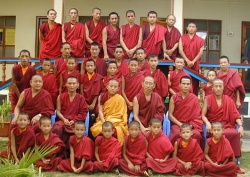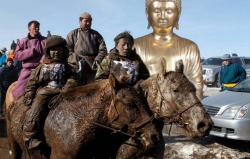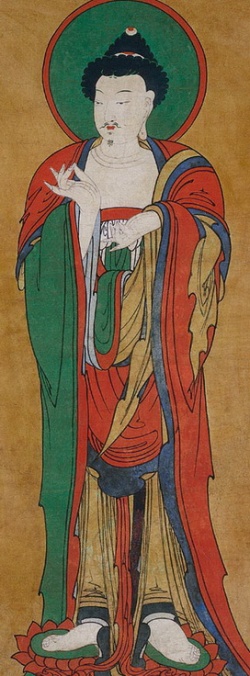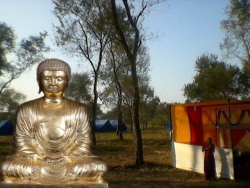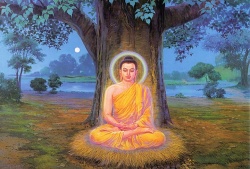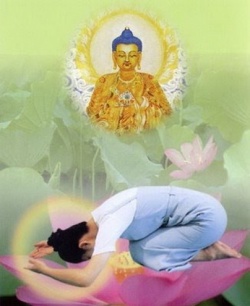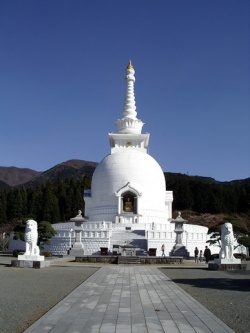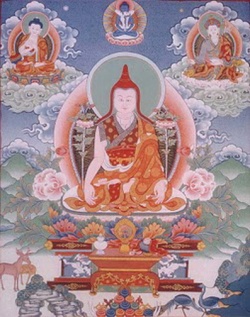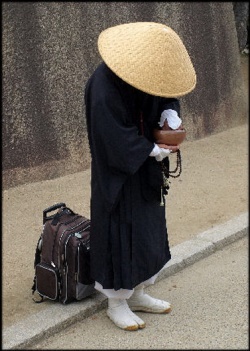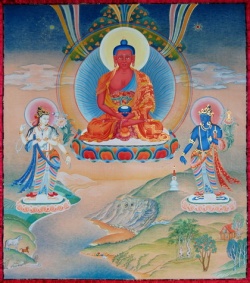Dialogue and Transformation: Buddhism in Asian Philosophy Michael Barnhart
A one-to-three week unit that covers the transformative influence Buddhism exerted over Asian philosophical thinking. Each of the three sections constitutes a full week of material; they may be used separately or in combination.
The materials attempt to bring a comparative perspective to the understanding of Asian philosophy by following the one major philosophical tradition that is truly pan-Asian. The unit does not assume that Buddhism is "one thing," but leaves the instructor free to draw parallels and connections between what were clearly different Buddhisms.
The overall theme of the entire unit is the development of selected philosophical concepts and issues in the Buddhist tradition and their contribution to Asian thought. These issues were selected not only because of their centrality within Buddhism but also their relevance to contemporary philosophical issues that students may encounter in their courses and intellectual development.
Key questions in the unit as a whole include: Is there such a thing as a Buddhist philosophy? How are such key concepts as "no-self" (anatta) and "emptiness" (sunyata) understood across different versions of Buddhism? What are the general moral or even political implications of such Buddhist concepts and doctrines?
Section I explores the oldest branch of Buddhism in the Indian Hindu context where it developed in critical confrontation with the traditional view of the self (Atman) and its metaphysical implications. Section II deals primarily with the contribution of Chinese Buddhism to the Confucian-Taoist (Daoist) debate over the exact nature of self-cultivation and represents an opportunity to think through some of the ethical implications of themes introduced in Section I. Finally, Section III examines the somewhat unusual Japanese Buddhist emphasis on the dangers of rationalizing thought as a form of egocentrism and thus the value of "without thinking" in action. This trend is also examined in terms of its role in the nativist concern with "Japaneseness" that emerges in the work of one of Japan's most famous Shinto thinkers, Motoori Norinaga. Taken together all three sections attempt to present a rounded picture of some of the more crucial philosophical aspects of the tradition.
For philosophy and religion courses, this unit affords an opportunity to present an important philosophical tradition in its own right as well as to explore metaphysical and ethical themes of general interest. As such the sections could be useful in a wide variety of courses from introductory survey courses to more specialized "topics" courses dealing with issues from philosophical psychology to ethics and politics.
For history and world literature courses, these materials can provide background wherever exposure to Asian thought is involved. Because Buddhism and its philosophical concepts have had such a large influence on Asian cultures, it is difficult to appreciate a work such as the Japanese Tale of Genji without some knowledge of basic Buddhist themes and ideas. Equally, it is important to understand the Buddhist contribution to Chinese ideas of self-cultivation in order to make sense out of later Chinese and Japanese conceptions regarding the roles and responsibilities of the ruler.
The materials in this unit encourage students to think critically about fundamental moral and metaphysical issues from a variety of perspectives that are still largely absent from the undergraduate study of philosophy. Issues of concern include:
What is the nature of the self and its place with respect to reality?
What is the fundamental constitution of reality? Are things substantial in nature or more of a process?
To what extent does our knowledge of things reflect our point of view as opposed to reality itself?
What is the source of moral or ethical concern? Is ethics based on something more fundamental than one's knowledge of rules or a specific set of dispositions?
Audiences and Uses
back to top
This unit is intended to fit into the following undergraduate courses:
Philosophy
Eastern philosophy
Asian and comparative religions
Introduction to Buddhism
Asian history and world history courses
World literature with an emphasis on themes in Asian thinking
Introduction to Chinese Culture
Introduction to Japanese Culture
Introduction to Asian or East Asian Cultures
Audience: The course material is pitched to a general, undergraduate level and presumes no specialized historical or philosophical knowledge.
Section I: Early Buddhism and Evolving Hindu Thought
back to top
Theme (Early Buddhism and Evolving Hindu Thought)
Buddhist philosophy arose in opposition to the prevailing development of Vedic (based on the sacred texts of Hinduism - (Vedas) thought. Taking a systematically different position on the nature of human salvation itself, Buddhism offered a reworking of such basic concepts as the "self" (or Atman), action (or karma), release from the suffering of worldly life (or Samsara), and the very permanence of ultimate reality itself.
The purpose of this section is to present one of the most pivotal of these "debates" between Buddhists and Hindus, that regarding the nature of the "self" and its connection to what is ultimately real. If there is one thread connecting all versions of Buddhism, it is the thesis of the impermanent and "empty" nature of the self, our misperception of which is the source of all suffering. That is, human suffering is ultimately rooted in a mistaken assumption that the transient self is something permanent and real, that the Hindu atman is an expression of the ultimately real - brahman.
This alternative raises real questions about how reality is constituted such that it gives the appearance of permanence. Is it that reality is just fleeting moments - dharmas - that pass away below the threshold of our noticing and on which we superimpose mere images of permanent things? Or is the fleeting reality of appearance always underlaid by a deeper but ultimately unknowable substratum or the really real? Are the various elements that combine to present the illusion of self themselves equally empty or do they enjoy a more permanent status?
The readings are meant not only to present traditional positions on these issues, together with some of the philosophical reasons for them, but also to show how the Buddhist position clearly influenced the thinking of Hinduism. A further theme is the reciprocal influence that the Hindu tradition had on Buddhism by pushing it increasingly in a metaphysical direction, as seen in the contrast between the early texts and the later works of Nagarjuna. It is important to emphasize that in many ways the Hindu tradition includes Buddhism as a dissident voice.
Instructor's Introduction (Early Buddhism and Evolving Hindu Thought)
The Hindu aspect of the section starts with selections from the Upanishads that define the self and demonstrate its place in ultimate reality. This section ends with a selection representing the non-dualist absolutism of Shankara (8th-9th century) - the view that there is only one ultimate reality, qualityless or nirguna Brahman, and that all distinctions whatsoever are false consciousness. For Buddhism, the early texts - which seek to deconstruct the self or atman - are followed by a short selection from the philosopher buddhaghosa (5th century) stressing the impermanence of all things and end with the equally non-dualist relativism (some prefer the term "relationalism") of Nagarjuna (1st-2nd centuries) - the position that there is only the co-arising of equally empty, insubstantial things.
Many of the readings can be paired as contrasting debate positions. For example, besides the obvious contrasts to be drawn between Shankara and Nagarjuna, (e.g. their respective concepts of "qualityless" nirguna Brahman and absolute emptiness or sunyata), one could also contrast the ways in which the chariot metaphor is used in these texts. The Katha Upanishad identifies the chariot with the body and the self (atman) as the rider, while the Buddhist selection "Questions for King Milinda," deconstructs the chariot itself and thus the entire concept of a unified self, replacing it with a doctrine of non-self egolessness (anatman). One can even imagine a hypothetical dialogue between these two texts, where the Vedic side insists that there is ultimately a self because there is always someone who drives our chariot to which the Buddhist responds that while the parts of the chariot may be apparent, the chariot as a whole isn't at all obvious or apparent. ("I see an axle, wheels, a car, and so on, but I fail to see the `chariot'" - i.e. something that isn't simply reducible to its component parts.) Of course, the point is to push this way of thinking further and ask questions regarding the so-called parts as well, in which case the entire Buddhist doctrine of universal emptiness comes into focus.
Instructor Readings (Early Buddhism and Evolving Hindu Thought)
All readings are marked according to the following system:
- Most Important
- Most Important
- Recommended
- Recommended
- Optional
Besides the works below, there are also the very excellent short introductions in Daniel BONEVAC and Stephen PHILLIPS, Understanding Non-Western Philosophy (Mayfield, 1993).
- MOHANTY, J.N. "Indian Philosophy: A Historical Overview." Chap. 1 in Classical Indian Philosophy. Lanham: Rowman and Littlefield, 2000. Pages 1-7.
- MOHANTY, J.N. "Indian Philosophy: A Historical Overview." Chap. 1 in Classical Indian Philosophy. Lanham: Rowman and Littlefield, 2000. Pages 1-7.
Historical overview of Indian philosophical traditions.
Student Readings (Early Buddhism and Evolving Hindu Thought)
Ideally, one should use all the required readings listed below. To assign a smaller amount of reading per session, choose readings according to the star (*) system. If there is only one day to devote to the topic, it might be best to stick entirely to the older material (indicated by ***).
- Most Important
- Most Important
- Recommended
- Recommended
- Optional
- "Katha Upanisad." In Upanisads, translated by Patrick OLIVELLE. Oxford: Oxford University Press, 1996. Chap. 2, verses 19-25 and chap. 3, verses 3-13. Pages 237-240.
- "Katha Upanisad." In Upanisads, translated by Patrick OLIVELLE. Oxford: Oxford University Press, 1996. Chap. 2, verses 19-25 and chap. 3, verses 3-13. Pages 237-240.
Crucial for explaining the chariot metaphor as applied to the self as well as the brahman/atman connection.
- "Mundaka Upanisad." In Upanisads, translated by Patrick OLIVELLE. Oxford: Oxford University Press, 1996. Chap. 2.2. Pages 272-274.
- "Mundaka Upanisad." In Upanisads, translated by Patrick OLIVELLE. Oxford: Oxford University Press, 1996. Chap. 2.2. Pages 272-274.
Offers a summary of Hindu metaphysics.
- "Chandogya Upanisad." In Upanisads, translated by Patrick OLIVELLE. Oxford: Oxford University Press, 1996. Chap. 6.1 and 6.2. Pages 148-149.
- "Chandogya Upanisad." In Upanisads, translated by Patrick OLIVELLE. Oxford: Oxford University Press, 1996. Chap. 6.1 and 6.2. Pages 148-149.
Explores the relationship between the ultimate (brahman) and the mundane through a series of everyday analogies.
- The Bhagavad-Gita: Krishna's Counsel in Time of War. Translated by Barbara Stoler MILLER. New York: Columbia University Press, 1986. Chap. 9 and 13. Pages 82-87; 115-119.
- The Bhagavad-Gita: Krishna's Counsel in Time of War. Translated by Barbara Stoler MILLER. New York: Columbia University Press, 1986. Chap. 9 and 13. Pages 82-87; 115-119.
More challenging selection but important in explaining the connection between the divine unity of all things as personified in the character of Krishna and its connection with the self.
- "Brahmasutra commentary of Sankhara (Introduction)." Translation: George THIBANT, The Vedanta Sutras of Badarayana. Sacred Books of the East, Oxford: Clarendon Press, 1890, 1896.
- "Brahmasutra commentary of Sankhara (Introduction)." Translation: George THIBANT, The Vedanta Sutras of Badarayana. Sacred Books of the East, Oxford: Clarendon Press, 1890, 1896.
Or as reprinted in: BONEVAC, Daniel and Stephen PHILLIPS, Understanding Non-Western Philosophy. Mayfield, 1993. Pages 198-200.
Or: RADHAKRISHNAN, Sarvepalli and Charles A. MOORE, eds. A Source Book in Indian Philosophy. Princeton: Princeton University Press, 1957. Pages 509-510.
The most formidable of the readings but important as a philosophically sophisticated Hindu account of how the illusion of self arises and why it may be given up as empty. In this sense it has important connections with Buddhist thought, particularly the selections from nagarjuna below.
Buddhism
Or as reprinted in:
MOORE, CHARLES A.; A SOURCE BOOK IN INDIAN PHILOSOPHY. ©1957 Princeton University Press, 1985 renewed PUP. Pages 274-275 reprinted by permission of Princeton University Press. download as PDF doc
Or: BONEVAC, Daniel and Stephen PHILLIPS. Understanding Non-Western Philosophy. Mayfield, 1993. Page 131.
The Buddha's first statement which lays out the major and common elements in the Buddhist tradition including the Four Noble Truths and the Eightfold Path.
- "Discussion of Dependent Origination." In Buddhism in Translations, edited and translated by Henry Clarke WARREN. New York: Atheneum, 1976. Pages 202-208.
- "Discussion of Dependent Origination." In Buddhism in Translations, edited and translated by Henry Clarke WARREN. New York: Atheneum, 1976. Pages 202-208.
Details the important Buddhist conception of "dependent co-arising" as understood in the early texts.
- "King Milinda and Nagasena Come to an Understanding " and "There is no Ego." download as PDF doc
- "King Milinda and Nagasena Come to an Understanding " and "There is no Ego." download as PDF doc
Pages 128-137 reprinted electronically by permission of the publisher from Buddhism in Translations: Passages Selected from the Buddhist Sacred Books and Translated from the Original Pali into English by Henry Clarke WARREN, Student's Edition, Harvard Oriental Series. 3., pp. 128-137, Cambridge, Mass.: Harvard University Press, 1896, 1922, Copyright ©1953, by the President and Fellows of Harvard
College.
This passage systematically deconstructs the idea of a unitary self through challenging the idea of an empirically evident and enduring object of any kind, in this case a chariot. May be usefully contrasted with the selection from the Katha Upanishad above where the self/chariot analogy is broached from a Hindu point of view.
- Buddhaghosa. "Duration of Life." In Buddhism in Translations, edited and translated by Henry Clarke WARREN. New York: Atheneum, 1976.
- Buddhaghosa. "Duration of Life." In Buddhism in Translations, edited and translated by Henry Clarke WARREN. New York: Atheneum, 1976.
Or: BONEVAC, Daniel and Stephen PHILLIPS, Understanding Non-Western Philosophy. Mayfield, 1993. Page 137 (same translation).
Very short selection introducing the important Buddhist concept of impermanence, particularly as applied to the life of a person.
- Nagarjuna. "Atma pariksa: Examination of the Bifurcated Self." Chap. 18 in Nagarjuna: A Translation of his Mulamadhyamakakarika with an Introductory Essay, by Kenneth K. INADA. Tokyo: Hokuseido Press, 1970. Pages 113-116.
- Nagarjuna. "Atma pariksa: Examination of the Bifurcated Self." Chap. 18 in Nagarjuna: A Translation of his Mulamadhyamakakarika with an Introductory Essay, by Kenneth K. INADA. Tokyo: Hokuseido Press, 1970. Pages 113-116.
This is the Buddhist companion to the Shankara selection above both in the points it makes and the difficulty of the text. One of the more challenging selections but important for understanding the reciprocal influence of Buddhism and Hinduism in their later stages.
Discussion Questions (Early Buddhism and Evolving Hindu Thought)
What are the different ways in which the Hindu and Buddhist sources use the chariot metaphor? What points are made regarding the nature of the self and its connection with reality? What implications with regard to reality in general might follow?
If you assign "Nagarjuna" and "Brahmasutra commentary of Sankhara" (both recommended [**] readings): Compare and contrast the non-difference of samsara and nirvana that Nagarjuna regards as the ultimate Buddhist insight with the non-difference expressed in Shankara's nirguna brahman. Are the different "non-differences" themselves different? In other words, are they different absolutism?
What does it mean to look at the world from the standpoint of anatman (no-self) and sunyata (emptiness)? How does this approach root out suffering (duhkha) or bring release (nirvana) from rebirth and worldly existence (samsara)?
Comparative Opportunity (Early Buddhism and Evolving Hindu Thought)
In regard to the repeated analogies between the self and a chariot, both in the Hindu Katha Upanishad and the Buddhist King Milinda selection, one might refer to Plato's use of the same analogy in the Phaedrus (246A-247C) to outline a rather different view of the self or soul. Interestingly, in Plato's use of the chariot and its driver as metaphor for the soul, it is the horses and the manner in which the driver controls them that is significant for understanding our inner nature, not the chariot itself as in the Buddhist case.
Further Reading (Early Buddhism and Evolving Hindu Thought)
General background - Hinduism
MOHANTY, J.N. Classical Indian Philosophy. Lanham: Rowman and Littlefield, 2000. Pages 117-122.
Covers ethical issues in the Bhagavad Gita and the first chapter is a historical overview of Indian philosophical traditions.
PHILLIPS, Stephen. Classical Indian Metaphysics: Refutations of Realism and the Emergence of "New Logic." Chicago: Open Court, 1995.
Chapters 1 and 2 cover what Phillips regards as the idealist-mystic tradition hailing from the Upanishads to Yoga and the realist tradition, especially as represented by the Nyaya-Vaishesika. Chapter 1 is probably more important.
Buddhism
For a general discussion of Buddhism, and especially its ethical precepts, see:
HARVEY, Peter. "The Shared Foundations of Buddhist Ethics." Chap. 1 in An Introduction to Buddhist Ethics: Foundations, Values and Issues. Cambridge: Cambridge University Press, 2000. Pages 8-59.
INADA, Kenneth K. "Introductory Essay." In Nagarjuna: A Translation of his Mulamadhyamakakarika with an Introductory Essay. Tokyo: The Hokuseido Press, 1970. Pages 3-34.
STRENG, Frederick J. Emptiness: A Study in Religious Meaning. Nashville: Abingdon Press, 1967.
KALUPAHANA, David J. Buddhist Philosophy: A Historical Analysis. Honolulu: The University Press of Hawaii Press, 1976.
A fine book-length introduction to the entire tradition, especially in India. Chapters 1-5 (pages 3-55) give a good, condensed account of basic early Buddhism.
KASULIS, Thomas P. Zen Action / Zen Person. Honolulu: University of Hawaii Press, 1981.
Still has one of the finest brief discussions of Nagarjuna and Middle-Way Madhyamika Buddhism. See especially chapter 2.
KOLLER, John M. Asian Philosophies. Upper Saddle River, N.J.: Prentice Hall, 2002.
Section II: Buddhist and Confucian Views of Self-Cultivation (Buddhism and China)
back to top
Theme (Buddhist and Confucian Views of Self-Cultivation)
The theme in this section is the influence of Buddhism in China, principally through its impact on Confucian social ethics. Buddhism contributes a unique understanding of the individual actor, not merely as a socially determined role player, but as a ground of spontaneous knowing and acting that arguably approximates Confucius's (551-479 B.C.) own insight that a cultivated humanity (jen or ren) rather than a rulebook is the most reliable guide to ethically appropriate action.
The readings move from classic Confucian text, a selection from the Analects that lays out the complex themes regarding self-cultivation and performance of ritualized action, through both the Taoist (Daoist) and later Buddhist emphasis on self-cultivation as a kind of antinomian spontaneity that builds on the notion of egolessness (anatta) as our true nature. Finally, many centuries later WANG Yang-Ming's (1472-1529) blend of these ideas in his Neo-Confucian understanding of the cultivated man as similarly spontaneous offers a second view of the absorption of Buddhist ideas into Asian intellectual culture.
Instructor's Introduction (Buddhist and Confucian Views of Self-Cultivation)
Buddhism came to China from Tibet in the early centuries of the Common Era. It encountered an intellectual culture with a lively philosophical debate regarding human nature and socio-political ethics. The principal "schools" of Chinese thought of this time included the Confucians, Taoists and others. Each expressed a somewhat different point of view concerning the fundamental goodness of human nature and therefore the proper prescription for maintaining order and good governance in the empire.
Customarily, it was thought that once one understood human character and its fundamental nature, whether good or bad, one then knew how to cultivate it to produce a harmonious society. Confucians and Taoists represented polar opposites in this debate, with the early Confucians arguing that whatever human nature was, it was susceptible to improvement by following the rites (li ) and rituals of tradition to the point of becoming a cultivated person (Chün-tzu or junzi) capable of recognizing the needs of others and creating harmonious order in society.
The Taoists argued that such cultivation was counterproductive in making one rigid and formulaic and that the empire would flourish when actions were more spontaneous, natural, and closer to the Tao (Dao, or "Way") itself. Bending or breaking rules and encouraging spontaneity were therefore superior to cultivation and slavish adherence to ritual for the Taoists
Metaphysically, the contrast was between the Confucian emphasis on the concrete as the direct experience of the overall Way or Tao (Dao) and the Taoist (Daoist) emphasis on the hidden and mysterious. This is particularly evident in the "butterfly selection" from the Chuang Tzu (Zhuangzi) where the "truth" of a human wakeful conception of reality is strongly challenged. Thus, for Confucians generally, the obvious and manifest, especially in the form of rules and rituals represented the Way. For Taoists (Daoists), the empty, such as in the empty space of a bell or a wheel hub, and the spontaneous ("Those who grasp, lose." Tao Te Ching (Dao De Jing) 29) represented the Way. The alternatives were social form or social formlessness.
The Confucian and Taoist (Daoist) positions suggest a possible middle way that Buddhism in part supplied. From the Buddhist standpoint, the self is empty and therefore socially conditioned. This equation of formlessness with form at the deepest level is evident in the Hua-yen (Huayan) selection from the "Treatise of the Golden Lion" where the interdependence of all phenomena attests to their empty nature and vice versa. But Chinese Buddhism, particularly the Ch'an (Chan) (Zen, in Japanese) form, went beyond the mere equivalence of emptiness and interdependent forms and offered a glimpse of the formless self within as a kind of Tao-like presence beyond the grasp of human reason. To reach such a realization therefore required a kind of cultivation but very different from the Confucian sort involving obedience and respect. Rather Ch'an (Chan) offered a series of radical challenges to rationality itself, driving one's experience beyond the bounds of language and meaning towards an experience of immediate formlessness. This is particularly evident in the selections from the "Conversations of I-Hsüan," (Yi Xuan) where rationally conceived attempts on the part of his students to answer his challenging questions are met with physical blows and verbal abuse. The point is to respond without answering, a kind of no-answer answer which cannot be anticipated and must be delivered entirely spontaneously
Widely attacked as immoral by Confucians, Buddhism would seem to fit more closely with Taoism (Daoism), particularly the selection from the Chuang-Tzu (Zhuangzi). However, over time Confucian thinkers found some of Buddhist metaphysics and even ethics consistent with their own ideas and began to incorporate Buddhist themes. As an example of this, the selection of texts ends with the Neo-Confucian thinker WANG Yang-Ming who is widely regarded as having integrated Buddhist conceptions of formlessness and individual spontaneity with a Confucian emphasis on self-cultivation. For Wang, "truth has no form" and is an "intuitive knowledge" native to the mind that is only obscured in those who act improperly.
Instructor Readings (Buddhist and Confucian Views of Self-Cultivation)
All readings are marked according to the following system:
- Most Important
- Most Important
- Recommended
- Recommended
- Optional
- KASULIS, Thomas P. Zen Action / Zen Person. Honolulu: University of Hawaii Press, 1981. Pages 29-52.
- KASULIS, Thomas P. Zen Action / Zen Person. Honolulu: University of Hawaii Press, 1981. Pages 29-52.
Chapters 3 and 4, which cover both Taoism and its impact on Chinese Ch'an (Chan) and Japanese Zen.
Student Readings (Buddhist and Confucian Views of Self-Cultivation)
All readings are marked according to the following system:
- Most Important
- Most Important
- Recommended
- Recommended
- Optional
The most convenient collection to use in terms of brevity and availability is the revised version of James LEGGE’s translation available in BONEVAC, Daniel and Stephen PHILLIPS. Understanding Non-Western Philosophy. Mayfield, 1993. pp. 242-48.
James LEGGE’s translation can also be found online at http://www.gutenberg.org/dirs/etext02/cnfcs10.txt. In particular, see the following selections (same as those featured in Bonevac and Phillips above):
Book 1, Chapters 1, 2, 4, 6-8, 11-12, 14-16;
Book 2, Chapters 1-5, 10, 12-17, 19-20, 24;
Book 4, Chapters 2-7, 10-12, 14-19, 22-25;
Book 5, Chapters 10-12;
Book 6, Chapters 18, 20, 23-25, 27-28;
Book 7, Chapters 27, 36-37;
Book 8, Chapters 2, 8, 13;
Book 9, Chapter 4;
Book 11, Chapter 11;
Book 12, Chapters 1-2, 9, 17, 22;
Book 13, Chapters 3, 6, 9, 11, 13, 16-19;
Book 14, Chapters 25, 30, 36;
Book 15, Chapters 2, 17-20, 23, 28, 38-40;
Book 16, Chapter 10;
Book 17, Chapters 2, 6, 8;
Book 20, Chapter
- WANG Yang-ming, Record of Discourses (selected)
- WANG Yang-ming, Record of Discourses (selected)
Use: "Inquiry on the Great Learning." In A Source Book in Chinese Philosophy, translated and compiled by Wing-Tsit CHAN. Princeton: Princeton University Press, 1963. Pages 659-667.
Or: DEBARY, William Theodore and Irene BLOOM. Sources of Chinese Tradition, 2nd edition, compiled by Wm. Theodore DEBARY and Irene BLOOM with the collaboration of Wing-Tsit CHAN et al. New York: Columbia University Press, 1999. Pages 842-853.
Or the selections provided in: BONEVAC, Daniel and Stephen PHILLIPS. Understanding Non-Western Philosophy. Mayfield, 1993. Pages 312-315.
Wang Yang-Ming, the famous Neo-Confucian philosopher of Ming-period China (1368-1644), is well-known for exhibiting the affinities between Confucianism and a number of important Buddhist ideas including the interdependence of all phenomena, the mind-dependence of all distinctions, and the need to overcome a delusional attachment to self in order to achieve the Confucian ideal of sage-like cultivation.
Taoism (Daoism)
- Lao-Tzu. Tao Te Ching. Translated by Stephen ADDISS and Stanley LOMBARDO. Indianapolis: Hackett Publishing Company, 1993. Chapters 1-3, 5, 11, 15-16, 19, 21, 38, 51, 57, 81.
- Lao-Tzu. Tao Te Ching. Translated by Stephen ADDISS and Stanley LOMBARDO. Indianapolis: Hackett Publishing Company, 1993. Chapters 1-3, 5, 11, 15-16, 19, 21, 38, 51, 57, 81.
Or: DEBARY, William Theodore and Irene BLOOM. Sources of Chinese Tradition, 2nd edition, compiled by Wm. Theodore DEBARY and Irene BLOOM with the collaboration of Wing-Tsit CHAN et al. New York: Columbia University Press, 1999. Pages 79-94.
Translations of the Tao Te Ching can be found online at:
• Translation by S. Mitchell
http://acc6.its.brooklyn.cuny.edu/~phalsall/texts/taote-v3.html
• Translation by James Legge
http://www.isop.ucla.edu/eas/documents/DaoDeJing.htm
Most accessible statement of the Taoist (Daoist) outlook and its connection to conduct with obvious affinities to Buddhist conceptions of emptiness (sunyata) and the doctrine of no-self (anatman).
- Chuang Tzu. "The Identity of Contraries." Chap. 2 in Chuang Tzu: Taoist Philosopher and Chinese Mystic, translated by Herbert A. GILES. London: Ruskin House, 1926. Pages 34-47.
- Chuang Tzu. "The Identity of Contraries." Chap. 2 in Chuang Tzu: Taoist Philosopher and Chinese Mystic, translated by Herbert A. GILES. London: Ruskin House, 1926. Pages 34-47.
Reprinted in: BONEVAC, Daniel and Stephen PHILLIPS. Understanding Non-Western Philosophy. Mayfield, 1993. Pages 273-277.
Or in: A Source Book in Chinese Philosophy, translated and compiled by Wing-Tsit CHAN. Princeton: Princeton University Press, 1963. Pages 179-181, 184, 186-190.
Or: DEBARY, William Theodore and Irene BLOOM. Sources of Chinese Tradition, 2nd edition, compiled by Wm. Theodore DEBARY and Irene BLOOM with the collaboration of Wing-Tsit CHAN et al. New York: Columbia University Press, 1999, Pages 96-111.
Chuang-tzu's (Zhuangzi's) work, though not necessarily representative of all Taoism (Daoism), decisively raises the issue of rationality and self-identity in ways that prefigure much of the Ch'an (Chan) (Zen, in Japanese) Buddhist material.
Buddhism
- "Treatise on the Golden Lion." In A Source Book in Chinese Philosophy, translated and compiled by Wing-Tsit CHAN. Princeton: Princeton University Press, 1963. Pages 409-414.
- "Treatise on the Golden Lion." In A Source Book in Chinese Philosophy, translated and compiled by Wing-Tsit CHAN. Princeton: Princeton University Press, 1963. Pages 409-414.
An important expression of the Hua-Yen (Huayan) school of Buddhism and one that is both uniquely Chinese and importantly influential, especially in regard to Neo-Confucianism.
- "The Platform Sutra." In A Source Book in Chinese Philosophy, translated and compiled by Wing-Tsit CHAN. Princeton: Princeton University Press, 1963. Pages 430-440.
- "The Platform Sutra." In A Source Book in Chinese Philosophy, translated and compiled by Wing-Tsit CHAN. Princeton: Princeton University Press, 1963. Pages 430-440.
Or: DEBARY, William Theodore and Irene BLOOM. Sources of Chinese Tradition, 2nd edition, compiled by Wm. Theodore DEBARY and Irene BLOOM with the collaboration of Wing-Tsit CHAN et al. New York: Columbia University Press, 1999. Pages 494-504.
Important expression of the Ch'an (Chan/Zen) school or "Sudden Enlightenment" school, many passages in the selection echo Taoist themes in Lao-tzu (Laozi) and Chuang-tzu (Zhuangzi).
- "The Recorded Conversations of Zen Master I-Hsüan." In CHAN, Wing-Tsit; A Source Book in Chinese Philosophy. ©1963 Princeton University Press, 1991 renewed PUP. Pages 444-449 reprinted by permission of Princeton University Press. download as PDF doc
- "The Recorded Conversations of Zen Master I-Hsüan." In CHAN, Wing-Tsit; A Source Book in Chinese Philosophy. ©1963 Princeton University Press, 1991 renewed PUP. Pages 444-449 reprinted by permission of Princeton University Press. download as PDF doc
See also: Yixuan. "Seeing into One's Own Nature." In DEBARY, William Theodore and Irene BLOOM. Sources of Chinese Tradition, 2nd edition, compiled by Wm. Theodore DEBARY and Irene BLOOM with the collaboration of Wing-Tsit CHAN et al. New York: Columbia University Press, 1999. Pages 504-508.
Famous and influential example of the Ch'an (Chan/Zen) method of teaching and philosophical perspective, in which the connection between rationality and enlightenment becomes as much an issue as it is for Chuang-tzu (Zhuangzi).
Discussion Questions (Buddhist and Confucian Views of Self-Cultivation)
What does Buddhist enlightenment offer to the Confucian/Taoist (Daoist) understanding of individual cultivation? Is spontaneity central in one way or another to all of these views? Is there a connection between emptiness and individual spontaneity? If Confucius followed his "heart's desire" would I-hsüan (Yixuan) approve?
Compare and contrast a "spontaneity"-based ethics with a "tradition"-based ethics.
Comparative Opportunities (Buddhist and Confucian Views of Self-Cultivation)
The disagreements between Confucianism, Taoism, and Buddhism over self-cultivation suggest comparison with Plato and Aristotle's differences over the nature and our knowledge of the good, and consequently how we cultivate the virtues or develop wisdom. Other comparisons may be drawn between recurring images of the mind as a mirror or as part of a broad net of reflecting mirrored jewels in Hua-Yen (Huayan) Buddhism and contrasting ideas and images in Western philosophy such as Leibnitz's notion of a universal, inter-reflecting system of self-contained monads.
Further Reading (Buddhist and Confucian Views of Self-Cultivation)
Confucianism
GRAHAM, A.C. Disputers of the Tao: Philosophical Argument in Ancient China. LaSalle, I.L.: Open Court, 1989.
See especially the Introduction for general background and Chapter 1 on Confucius, pages 1-33.
A Confucian Life in America: Tu Wei-ming. [Video] Produced and directed by Gail Pellett. (From the series A World of Ideas with Bill Moyers.) Princeton, NJ: Films for the Humanities and Sciences. 1990.
Running Time: 30 minutes
Format: VHS and DVD
Available from many university libraries or from Films for the Humanities and Social Sciences. http://www.films.com/id/7662/A_Confucian_Life_in_America_Tu_Wei-ming.htm
Bill Moyers and Harvard University Professor Tu Wei-ming discuss what Confucian philosophy can offer contemporary society.
Reciprocal influence and shared themes between these views:
TU, Wei-Ming. "The `Moral Universal' from the Perspectives of East Asian Thought." Chap. 1 in Confucian Thought: Selfhood as Creative Transformation. Albany: State University of New York Press, 1985. Pages 19-33.
Section III: Buddhism in Japan: Esotericism, Pure Land, and the Development of Shinto
back to top
Theme (Buddhism in Japan)
This section focuses on the development of two uniquely Japanese Buddhist forms - Kukai's (774-835) Shingon Buddhism with its conception of this world as the body of Buddha and Shinran's (1173-1262) Shin or Pure Land Buddhism and its notion of complete self-surrender to Amida Buddha. The conceptual influence of these forms is traced through the emergence of the Shinto Nativism of the influential 18th-century thinker MOTOORI Norinaga and his arguments in favor of a specifically Japanese way of thinking and being.
Instructor's Introduction (Buddhism in Japan)
Though Japanese Buddhism is often associated with Zen, this unit focuses on two less well-known forms of Buddhist thinking that were uniquely influential, largely through two ideas. The first is associated with the famous 8th-9th century Buddhist master Kukai and his distinctive idea of this universe as literally the one Buddha body. Each and every phenomenon becomes sacred insofar as it becomes directly expressive of Buddha-nature, thus endowing the everyday world with elevated religious significance. The second idea emerges from Pure Land Buddhism and is found in the thinking of another extremely influential Japanese thinker, Shinran. This is the idea that Buddhist enlightenment is not a rational or cognitive process but a self-surrender, a giving up of one's very rationality (what Shinran calls "rational calculation") as inauthentic and selfish in favor of a "sincere expression of faith" (shinjin) in Amida Buddha (through the nembetsu).
These twin ideas, the rejection of all rationalizing thought and the sacredness of present, physical reality, are pursued through the thinking of the Shinto revival, also known as Shinto Nativism or National Learning (Kokugaku) as exemplified in the thinking of MOTOORI Norinaga. Ironically, Motoori deploys these same sorts of considerations against what he sees as the foreign (Chinese) imports of Confucianism as well as against Buddhism itself. For Motoori, the rejection of rationalism does not lead to an embrace of the Buddha and the salvation of the Pure Land but an embrace of what is uniquely Japanese as expressed in the ancient chronicles (the Kojiki and Nihon Shoki). Thus, Motoori sets the intellectual stage for the concern with "Japaneseness" and the creation of National Learning , a nativist application of Kukai's concern with the here and now.
Finally, the section presents selections from the works of two important 20th century philosophers who wrote on social issues - WATSUJI Tetsuro (1889-1960) and TANABE Hajime (1885-1962). Watsuji's Ethics in Japan incorporated a number of Buddhist themes into a conception of "betweenness" as the ethical thread gluing societies together. TANABE, referring specifically to Shinran and his conceptions of sincerity, argued that in the aftermath of World War II Japan needed to embark on a process of deep reflection and repentance, what he called "metanoia ."
Instructors may want to compare the different directions Japanese Buddhist themes of antirationalism and sacred space have taken through the juxtaposition of these later thinkers with the nativism of Motoori. Philosophically, one might also wish to pursue issues of moral and political ambiguity in Buddhist thinking generally.
Instructor Readings (Buddhism in Japan)
All readings are marked according to the following system:
- Most Important
- Most Important
- Recommended
- Recommended
- Optional
- KASULIS, Thomas P. "Intimacy: A General Orientation in Japanese Religious Values." Philosophy East and West 40, no. 4 (1990): 433-449. (Available through JSTOR.)
- KASULIS, Thomas P. "Intimacy: A General Orientation in Japanese Religious Values." Philosophy East and West 40, no. 4 (1990): 433-449. (Available through JSTOR.)
A persuasive look at the general social and ethical orientation of Japanese thought and thus the basis for Watsuji's conception of "betweenness."
- CARTER, Robert E. "Introduction to Watsuji Tetsuro's Rinrigaku." In Watsuji Tetsuro's Rinrigaku: Ethics in Japan, translated by Yamamoto Seisaku and Robert E. Carter. Albany: State University of New York Press, 1996. Pages 1-6.
A clear and interesting survey of Watsuji and his place in Japanese philosophy.
Student Readings (Buddhist and Confucian Views of Self-Cultivation)
All readings are marked according to the following system:
- Most Important
- Most Important
- Recommended
- Recommended
- Optional
- Kukai. "Attaining Enlightenment in this Very Existence." In Kukai: Major Works, translated by Yoshito S. HAKEDA. New York: Columbia University Press, 1972. Pages 225-234.
- Kukai. "Attaining Enlightenment in this Very Existence." In Kukai: Major Works, translated by Yoshito S. HAKEDA. New York: Columbia University Press, 1972. Pages 225-234.
Major early Japanese Buddhist philosopher who emphasized the body (as opposed to the Hua-yen emphasis on mind, for example) as the vehicle of enlightenment.
- Shinran. In Yoshifumi UEDA and Dennis HIROTA, Shinran: An Introduction to His Thought. Tokyo, Japan: Jodo Shinshu Hongwanji-ha, 1989. Pages 185-202, 219-232, 237-238, 255-256. download as PDF doc
- Shinran. In Yoshifumi UEDA and Dennis HIROTA, Shinran: An Introduction to His Thought. Tokyo, Japan: Jodo Shinshu Hongwanji-ha, 1989. Pages 185-202, 219-232, 237-238, 255-256. download as PDF doc
Reprinted electronically by permission of the publisher.
Buddhist philosopher responsible for Shin and Pure Land. He is especially important to this unit in terms of his rejection of "rational calculation" as the last refuge of the ego-self and the need for complete self-surrender to Amida Buddha.
Shinto Nativism / National Learning (Kokugaku)
- MOTOORI, Norinaga. "Wonder." In Sources of Japanese Tradition, vol. 2, compiled by Ryusaku TSUNODA, Wm. Theodore DE BARY, and Donald KEENE. New York: Columbia University Press, 1958. Pages 19-22.
- MOTOORI, Norinaga. "Wonder." In Sources of Japanese Tradition, vol. 2, compiled by Ryusaku TSUNODA, Wm. Theodore DE BARY, and Donald KEENE. New York: Columbia University Press, 1958. Pages 19-22.
Eighteenth century thinker in many ways responsible for the Shinto revival in Japanese thinking. The selection captures his critique of rationality as a path to deep truth about identity.
- NISHIMURA, Sey. "The Way of the Gods: Motoori Norinaga's Naobi no Mitama," Monumenta Nipponica 46, no. 1 (1991): 21-41. Available on JSTOR.
- NISHIMURA, Sey. "The Way of the Gods: Motoori Norinaga's Naobi no Mitama," Monumenta Nipponica 46, no. 1 (1991): 21-41. Available on JSTOR.
This selection captures Motoori's elevation of tradition as a source of authoritative truth, precisely because it discounts rational standards of evidence.
Social Ethics
- INADA, Kenneth K. "Japan." In Encyclopedia of Ethics, vol. 2, ed. 2. New York: Routledge, 2001. Pages 901-905.
- INADA, Kenneth K. "Japan." In Encyclopedia of Ethics, vol. 2, ed. 2. New York: Routledge, 2001. Pages 901-905.
A brief but incisive survey of a number of Japanese thinkers in terms of their views on ethics.
- WATSUJI, Tetsuro. "The Significance of Ethics as the Study of Ningen." Chap. 1 in Watsuji Tetsuro's Rinrigaku: Ethics in Japan, translated by Yamamoto Seisaku and Robert E. Carter. Albany: State University of New York Press, 1996. Pages 9-27.
- WATSUJI, Tetsuro. "The Significance of Ethics as the Study of Ningen." Chap. 1 in Watsuji Tetsuro's Rinrigaku: Ethics in Japan, translated by Yamamoto Seisaku and Robert E. Carter. Albany: State University of New York Press, 1996. Pages 9-27.
A selection from the modern philosopher Watsuji's major work, where he develops a Buddhist-like concept of social interdependence as the source of ethical values.
- TANABE, Hajime. "Preface." In Philosophy as Metanoetics, translated by Takeuchi Yoshinori. Berkeley: University of California Press, 1986. Pages xlix-lxii.
An important twentieth-century figure, here Tanabe argues for the need for a kind of deep meditative and critical perspective in order to properly reflect on the Japanese involvement in World War II. He directly invokes Shinran's ideas of self-surrender.
Discussion Questions (Buddhism in Japan)
To what extent can Motoori's nativist justification of his Shinto embrace of Japan's past (on the basis of a Buddhist-like distrust of rational self-calculation) be seen as a problem for Buddhism? Does it open moral or political ambiguities regarding the practical ramifications of a Buddhist perspective? Could a consistent Buddhist similarly embrace the mystical importance of ancient Japanese texts?
What role does physical context in Kukai's sense play in Japanese Buddhist thinking? For example, how does it influence Watsuji's conception of ethics? What are the implications of Kukai's assertion that the physical universe is literally the one Buddha body?
Comparative Opportunities (Buddhism in Japan)
In "Joseph De Maistre and the Origins of Fascism," Isaiah BERLIN argued that De Maistre's defense of "the importance of mystery and darkness-and above all of unreason" formed the very basis for modern fascism. The point invites interesting comparisons with material from Shinran and MOTOORI Norinaga especially where a similarly hostile position to the value of "rational calculation" is articulated. Does a Buddhist embrace of "unreason" form an intellectual backdrop to the temptation of East Asian forms of fascism?
Another comparative theme, given Shinran's rejection of "rational calculation," might be Kierkegaard's concept of authentic religious experience and its relation to thought and selfhood (see especially Fear and Trembling.)
